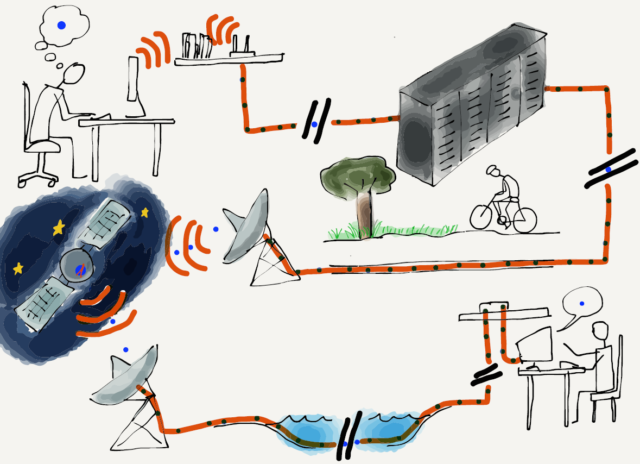Now that we can move data across a single link, it’s time to figure out how to move it across the country or around the world.
To send data from your computer to any of a billion destinations, the data needs to move across multiple hops and across multiple networks. When you travel from your home to a distant destination, you might walk from your home to a bus stop, take a train to the city, take another train to the airport, take a plane to a different airport, take a taxi into the city, then take a train to a smaller town, a bus to an even smaller town, and finally walk from the bus stop to your hotel. A packet also needs to take multiple forms of transportation to reach its destination. For a packet taking its “trip” to another country, the “walk”, “bus”, “train”, and “plane” can be thought of as different link layers like WiFi, Ethernet, fiber optic, and satellite.
At each point during the trip, you (or your packet) are being transported using a shared medium. There might be hundreds of other people on the same bus, train, or plane, but your trip is different from that of every other traveller because of the decisions that you make at the end of each of your “hops”. For instance, when you arrive at a train station, you might get off one train, then walk through the station and select a particular outbound train to continue your journey. Travellers with different starting points and destinations make a different series of choices. All of the choices you make during your trip result in you following a series of links (or hops) along a route that takes you from your starting point to your destination.
As your packet travels from its starting point to its destination, it also passes through a number of “stations” where a decision is made as to which output link your packet will be forwarded on. For packets, we call these places “routers”. Like train stations, routers have many incoming and outgoing links. Some links may be fiber optic, others might be satellite, and still others might be wireless. The job of the router is to make sure packets move through the router and end up on the correct outbound link layer. A typical packet passes through from five to 20 routers as it moves from its source to its destination.

But unlike a train station where you need to look at displays to figure out the next train you need to take, the router looks at the destination address to decide which outbound link your packet needs to take. It is as if a train station employee met every single person getting off an inbound train, asked them where they were headed, and escorted them to their next train. If you were a packet, you would never have to look at another screen with a list of train departures and tracks!
The router is able to quickly determine the outbound link for your packet because every single packet is marked with its ultimate destination address. This is called the Internet Protocol Address, or IP Address for short. We carefully construct IP addresses to make the router’s job of forwarding packets as efficient as possible.